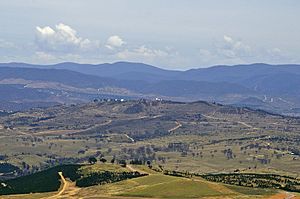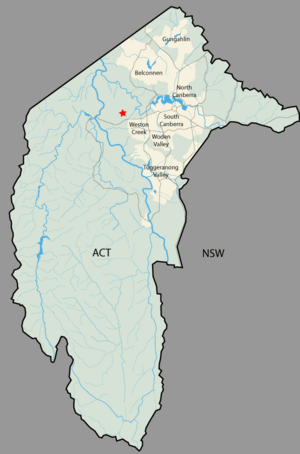Mount Stromlo facts for kids

Mount Stromlo is a mountain located west of the centre of Canberra, Australia. It is close to the area called Weston Creek. The mountain is about 751 metres (2,464 feet) above sea level and stands about 200 metres (656 feet) taller than the flat land around it.
At the very top of Mount Stromlo is the Mount Stromlo Observatory, which is run by the Australian National University. Near the mountain, you'll also find Canberra's main water treatment plant. This plant gets its water from the Cotter River area. You can reach the mountain by road using Cotter Road on the south side, or Uriarra Road on the east and north. A road connecting to Cotter Road, just outside Duffy, leads right up to the summit.
Contents
History of Mount Stromlo
Mount Stromlo was once part of Yarralumla Station. This was a large farm that is now used as the home for the Governor-General of Australia. Frederick Campbell named the mountain Mount Stromlo in the 1880s. However, no one knows for sure where he got the name from.
Building the Observatory
In 1910, a scientist named Pietro Baracchi chose Mount Stromlo as the perfect place for an observatory. The very first telescope, called the Oddie telescope, was set up there on September 8, 1911. The building that held this telescope was the first one ever built by the Australian government in Canberra! In January 1913, the first telephone line was connected to the Queanbeyan phone system.
The 2003 Bushfires
Mount Stromlo was badly burned by huge bushfires in 2003. The fires destroyed a large forest of pine trees that covered the mountain. They also caused a lot of damage to the observatory and the water treatment plant.
Sports and Activities at Stromlo
Before the 2003 fires, Mount Stromlo had some of the oldest and best mountain bike trails in Australia. After the fires, the trails were rebuilt and made even bigger starting in May 2006.
Stromlo Forest Park
Today, Stromlo Forest Park offers more than 35 km (22 miles) of cross-country single trails for mountain biking. It also has a Four-Cross course, several areas for observed trials (where riders overcome obstacles), and a downhill track.
In 2009, the Union Cycliste Internationale Mountain Bike and Trials World Championships were held at Mount Stromlo. About 30,000 visitors from up to 40 different countries came to watch this big event. More than 750 of the world's best riders competed in four mountain bike sports: Cross Country, Downhill, Four Cross, and Observed Trials.
Other Fun Things to Do
Mount Stromlo also has a large building for events, with offices and change rooms. There is a playground for children, areas for barbecues, and a special circuit for road cycling. You can also find a grass track for cross-country running and trails for horse riding.
Geology of Mount Stromlo
The main rock found on Mount Stromlo is called ignimbrite. This rock was formed from a volcanic eruption that happened a very long time ago, during the upper Silurian period. This ignimbrite covers an even older rock called rhyodacite. You can see the rhyodacite on the lower slopes of the mountain, especially on the east and southeast sides.
Rock Formations and Faults
The northern lower slopes of Mount Stromlo are covered with a type of rock called calcareous shale, which also formed during the Silurian period. This shale is cut off on the northwest side by something called the Winslade Fault. A fault is like a big crack in the Earth's crust where rocks have moved. This fault goes northeast towards Cook and Kaleen. Another smaller fault branches off east from the Winslade Fault and goes under the Scrivener Dam.
On the other side of these faults (to the northwest and north), you'll find more volcanic rocks made of rhyodacite from the middle Silurian period. The northern side of the mountain has been pushed up higher compared to the southern side.
Landforms and Water Flow
Stoney Creek and its smaller streams collect water from the north side of Mount Stromlo. The east side of the mountain drains into the Molonglo River. Water from the south side flows into Blugar Creek, which then runs into the Murrumbidgee River.
The very top of the mountain, near the observatory, runs in a north-south direction. There is also a smaller ridge, or spur, that runs to the southwest. This is where the water treatment plant is located.
See also
 In Spanish: Monte Stromlo para niños
In Spanish: Monte Stromlo para niños


